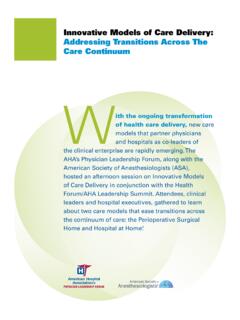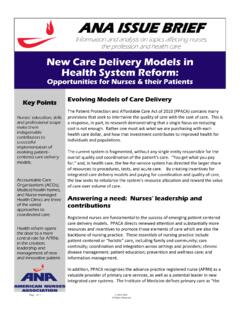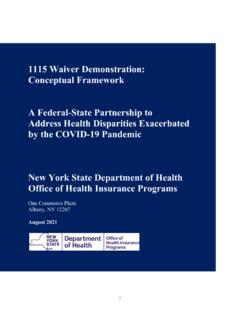Transcription of Partnering with ACOs for Population Health Improvement
1 Page 2 of 3 Partnering With Accountable care Organizations for Population Health Improvement Acknowledgments and Disclaimer Acknowledgments This document was developed in June 2015 by the Centers for Disease Control and Prevention (CDC) and ICF International with funding support under contract GS-23F-9777H (200-2011-F-42017). CDC recognizes the following people for their contributions. Contributing Writer and Researcher Brooke A. Carlson, North Sky Health Consulting, LLC Special thanks to the County of San Diego Health and Human Services Agency and Austen BioInnovation Institute for contributing their stories.
2 Advisors and Reviewers Nicole Flowers, CDC Bernadette Ford Lattimore, CDC Cindy Getty, CDC Sherry Maxy, CDC Emily Hite, ICF International Drew Bradlyn, ICF International Michael Orta, ICF International Special thanks to Linda A. Baffo at ICF International for her project support. Disclaimer The findings and conclusion in this issue brief are those of the authors and do not necessarily represent the views or official position of the US Department of Health and Human Services or CDC. Website addresses of nonfederal organizations are provided solely as a service to readers. Provision of an address does not constitute an endorsement of this organization by CDC or the federal government, and none should be inferred.
3 CDC is not responsible for the content of other organizations web pages. Table of Contents Table of Contents Introduction .. 1 Accountable care Organizations .. 1 Opportunities for Partnering With ACOs .. 2 Examples of Promising ACO Partnerships .. 3 Recommendations for Partnering With ACOs .. 5 The Path Ahead .. 6 Additional Resources .. 6 References .. 7 Page 1 of 7 Introduction This issue brief describes accountable care organizations (ACOs), and how public Health agencies and community organizations ( , faith-based organizations, academic institutions, agencies on aging, community wellness and prevention organizations) can work with ACOs to improve community Health outcomes, specifically for older adults.
4 This brief also includes information about the ACO model of coordinated care , opportunities for Partnering with ACOs, and recommendations from public Health agencies and community organizations on how to facilitate effective collaboration with ACOs. Accountable care Organizations The Affordable care Act called for the establishment of ACOs to help improve patient care while controlling rising Health care costs. Typically, ACOs are networks of hospitals, physicians, and other Health care providers that share responsibility for providing care to patients. ACOs create financial incentives to cooperate, share information, and save money, while providing coordinated, high-quality care to their Medicare patients2 primarily adults age 65 and older.
5 Coordinated care means providers exchange important clinical information about their patients with clear, shared expectations about their This helps to ensure that chronically ill patients get the right care at the right time, while avoiding .. duplication of services. 2 Essentially, ACOs organize the different elements of the Health care system ( , hospitals, primary care , specialists, home Health care ) to ensure the parts work well together for the patient. Community prevention efforts to improve Population Health are also important elements of ACO partnership models. Such partnerships between ACOs and community prevention efforts are sometimes called accountable care communities (ACCs) or accountable communities for Health .
6 ACOs focus on improving individual Health and also improving the Health of the entire Population for which they are accountable. This is known as Population Health ACOs improve Population Health by focusing on prevention and carefully managing patients with chronic diseases. Incentives (such as tying reimbursement of providers to quality care metrics or fining hospitals for unplanned hospital readmissions) encourage ACO members to provide high-quality care to improve their patients Health and to maintain their patients Health status. While there are numerous implementation models for ACOs designed to meet the needs Only 10% of Health outcomes are a result of the medical care system, whereas.
7 50-60% are because of Health behaviors. To change Health behaviors, it will be necessary to engage in activities that reach beyond the clinical setting and incorporate community and public Health systems. 1 Page 2 of 7 of diverse providers and populations, this issue brief will address the application of the ACO model to Medicare populations. Research shows that a small percent of Medicare beneficiaries with multiple chronic conditions account for the vast majority of Medicare spending, all too often due to inadequate care , poor communications, and weak adherence by patients. 5 As ACOs proliferate, with an estimated 250 to 500 ACOs nationwide in 2013,5, 6 the positive impact of coordinating care for chronically ill older adults is becoming clear, as evidenced by the following quotes: According to an article on eldercare and care coordination, A decade of research and demonstrations has developed evidence regarding care coordination interventions that are effective in achieving both improved beneficiary outcomes and reduced Medicare expenditures.
8 5 According to Eldercare Workforce Alliance and the National Coalition on care Coordination, Evidence in support of these programs [ care coordination] for older adults includes lower mortality, lower costs, lower hospital admissions, and less frequent use of expensive services. 7 According to the National Coalition on care Coordination, Coordinated care can improve quality of care and life for older adults by improving communication among providers, older adults and families; streamlining services; eliminating duplication .. and connecting older people with appropriate care . 8 Opportunities for Partnering With ACOs ACOs foster internal coordination and partnership with payers.
9 However, according to a 2013 survey of 115 Health care executives conducted by the Health care Improvement company Premier, Inc., over half of all ACOs in the United States also partner with external organizations ( , Health departments, large employers, other providers). According to this survey, partnership with local public Health departments is common, particularly among small, rural, or stand-alone As ACOs focus increasingly on improving Population Health , they must consider how to adopt Population -based strategies, which are often under the purview of local Health departments. Valuable opportunities exist for ACOs to collaborate with external partners ( , public Health agencies, community organizations) to improve the Health of older adults.
10 Physicians and hospitals cannot alone meet the standards and requirements for the preventive Health , care coordination, and at-r isk Population quality measures. As the Association of State and Territorial Health Officials notes, F or ACOs to be successful and for any Health system to be truly integrated, public Health must be at the table. 9 Public Health departments bring not only expertise in the core functions of public Health assessment, No single segment of Health care can manage the Health of a Population on its own; consequently, success will be easier to achieve with partnerships that span the care continuum.

















